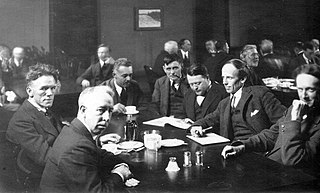
The Group of Seven, once known as the Algonquin School, was a group of Canadian landscape painters from 1920 to 1933, with "a like vision". It originally consisted of Franklin Carmichael (1890–1945), Lawren Harris (1885–1970), A. Y. Jackson (1882–1974), Frank Johnston (1888–1949), Arthur Lismer (1885–1969), J. E. H. MacDonald (1873–1932), and Frederick Varley (1881–1969). A. J. Casson (1898–1992) was invited to join in 1926, Edwin Holgate (1892–1977) became a member in 1930, and Lionel LeMoine FitzGerald (1890–1956) joined in 1932.

The Beaver Hall Group refers to a Montreal-based group of Canadian painters who met in the late 1910s while studying art at a school run by the Art Association of Montreal. The Group is notable for its equal inclusion of men and women artists, as well as for its embrace of Jazz Age modernism. They painted a variety of subjects, including portraits, landscapes, urban scenes and still lifes, in a mix of Modernist and traditional styles.

Emily Carr was a Canadian artist who was inspired by the monumental art and villages of the First Nations and the landscapes of British Columbia. She also was a vivid writer and chronicler of life in her surroundings, praised for her "complete candour" and "strong prose". Klee Wyck, her first book, published in 1941, won the Governor General's Literary Award for non-fiction and this book and others written by her or compiled from her writings later are still much in demand today.

The Art Gallery of Ontario is an art museum in Toronto, Ontario, Canada, located in the Grange Park neighbourhood of downtown Toronto, on Dundas Street West. The building complex takes up 45,000 square metres (480,000 sq ft) of physical space, making it one of the largest art museums in North America and the second-largest art museum in Toronto, after the Royal Ontario Museum. In addition to exhibition spaces, the museum also houses an artist-in-residence office and studio, dining facilities, event spaces, gift shop, library and archives, theatre and lecture hall, research centre, and a workshop.

Lawren Stewart Harris LL. D. was a Canadian painter, best known as a leading member of the Group of Seven. He played a key role as a catalyst in Canadian art and as a visionary in Canadian landscape art.

Franklin Carmichael was a Canadian artist and member of the Group of Seven. Though he was primarily famous for his use of watercolours, he also used oil paints, charcoal and other media to capture the Ontario landscapes. Besides his work as a painter, he worked as a designer and illustrator, creating promotional brochures, advertisements in newspapers and magazines, and designing books. Near the end of his life, Carmichael taught in the Graphic Design and Commercial Art Department at the Ontario College of Art.

Heffel Fine Art Auction House is a division of Heffel Gallery Limited. Heffel maintains offices in Vancouver, Calgary, Toronto, Ottawa and Montreal.

Helen Barbara Howard was a Canadian painter, wood-engraver, drafter, bookbinder and designer who produced work consistently throughout her life, from her graduation in 1951 from the Ontario College of Art until her unexpected death in 2002.

Canadian art refers to the visual as well as plastic arts originating from the geographical area of contemporary Canada. Art in Canada is marked by thousands of years of habitation by Indigenous peoples followed by waves of immigration which included artists of European origins and subsequently by artists with heritage from countries all around the world. The nature of Canadian art reflects these diverse origins, as artists have taken their traditions and adapted these influences to reflect the reality of their lives in Canada.

Joan Arden Charlat Murray is an American-born Canadian art historian, writer and curator who is an advocate for Canadian art and curators.
Doris Louise Huestis Speirs was a Canadian ornithologist, artist and poet. The "Doris Huestis Speirs Award" is an annual prize bestowed by the Society of Canadian Ornithologists to "an individual who has made outstanding lifetime contributions in Canadian ornithology". A member of the Art Students' League of Toronto and an art patron, she was the first Canadian to buy a Georgia O'Keeffe painting.
Edna Jeanette Taçon, whose name is often written, incorrectly, as Edna Tacon, was a Canadian pioneer of modernism.
Alexandra Biriukova was a Canadian architect and nurse. She is known for being the first woman in the Ontario Association of Architects and for her design of Lawren Harris's residence. She was the second woman to register as an architect in Canada.
Lillian Irene Hoffar Reid was a Canadian painter. She was in the first graduating class, June 1929, at the Vancouver School of Decorative and Applied Art. She taught at the Vancouver School of Art from 1933 to 1937.

Joane Cardinal-Schubert LL. D was a First Nations artist from Alberta, Canada. She was a member of the Royal Canadian Academy of Arts. She was an activist for Native sovereignty.
Wanda Nanibush is an Anishinaabe curator, artist and educator based in Toronto, Ontario. From 2016 to 2023, she held the position of the inaugural curator of Indigenous Art at the Art Gallery of Ontario: she resigned in 2023.
Edith Carr was an American-Canadian China-painter and founder of the YWCA in Victoria, British Columbia. Most notably, she was the elder sister of Canadian artist Emily Carr. While Edith's artistry never received the same level of recognition as her sister, she won several awards for her donations to non-profit religious organizations. Carr raised the funds she would later donate by selling her painted ceramic pieces at Christmas bazaars.
Georgiana Uhlyarik-Nicolae, also known as Georgiana Uhlyarik is a Romanian-born Canadian art curator, art historian, and teacher. She is currently the Fredrik S. Eaton Curator of Canadian Art at the Art Gallery of Ontario (AGO). She has been part of the team or led teams that created numerous exhibitions, on subjects such as Betty Goodwin, Michael Snow, and Kathleen Munn among others and collaborated with art organizations such as the Tate Modern, and the Jewish Museum, New York.
Michelle Jacques is a Canadian curator and educator known for her expertise in combining historical and contemporary art, and for her championship of regional artists. Originally from Ontario, born in Toronto to parents of Caribbean origin, who immigrated to Canada in the 1960s, she is now based in Saskatoon, Saskatchewan.
Anique Jordan is a Canadian multi-disciplinary artist, writer, curator and entrepreneur known for her work in photography, sculpture, and performance. Her artwork challenges historical narratives, reinterpreting the past in order to develop a vision of the future. Among her themes are black history in Canada, working-class communities, the relationship between the country's black and Indigenous peoples, and the work black people have put into explaining and fighting against racism.









